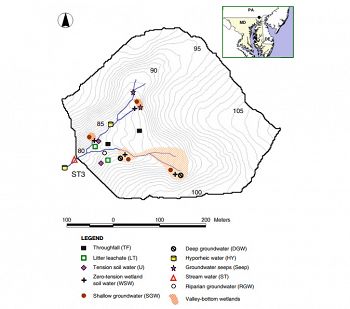Inamdar et al., 2011
Dissolved organic matter (DOM) concentration and quality in a forested mid-Atlantic watershed, USA.
Inamdar, S., Finger, N., Singh, S., Mitchell, M., Levia, D., Bais, H., Scott, D., and McHale, P. (2011)
Biogeochemistry 108 (1) 55-76
-
Christina, INVESTIGATOR
-
Christina, INVESTIGATOR
Abstract
Location of the study site in the Piedmont region of northeastern Maryland (inset indicated by filled circle) and the sampling locations within the 12 ha study watershed.
Understanding the quantity and quality of dissolved organic matter (DOM) in potential watershed sources is critical for explaining and quantifying the exports of DOM in stream runoff. Here, we examined the concentration and quality of DOM for ten watershed sources in a 12 ha forested catchment over a two-year period. DOM composition was evaluated for: throughfall, litter leachate, soil water (zero and tension), shallow and deep groundwater, stream water, hyporheic zone, and groundwater seeps. DOM quality was measured using a suite of optical indices including UV–visible absorbance and PARAFAC modeling of fluorescence excitation-emission matrices (EEMs). DOM concentrations and quality displayed a pronounced trend across watershed sources. Surficial watershed sources had higher DOM concentrations and more humic-like DOM with higher molecular weight whereas deeper groundwater sources were rich in % protein-like fluorescence. The greater % contribution of protein-like fluorescence in groundwater suggested that a larger fraction of groundwater DOM may be bioavailable. DOM for wetland groundwater was more aromatic and humic-like than that at the well-drained riparian location. Principal component analyses (PCA) revealed that the differences in surficial watershed compartments were dictated by humic-like components while groundwater sources separated out by % protein-like fluorescence. Observations from optical indices did not provide any conclusive evidence for preferential association of dissolved organic carbon (DOC) or dissolved organic nitrogen (DON) with any particular DOM quality pools.
Citation
Inamdar, S., Finger, N., Singh, S., Mitchell, M., Levia, D., Bais, H., Scott, D., and McHale, P. (2011): Dissolved organic matter (DOM) concentration and quality in a forested mid-Atlantic watershed, USA . Biogeochemistry 108 (1) 55-76. DOI: 10.1007/s10533-011-9572-4
Explore Further



